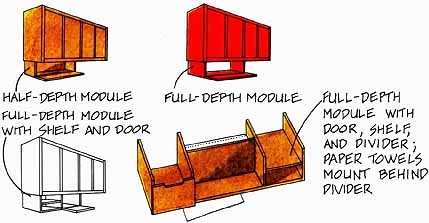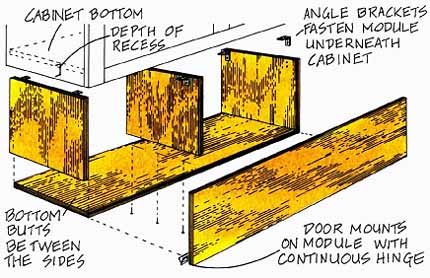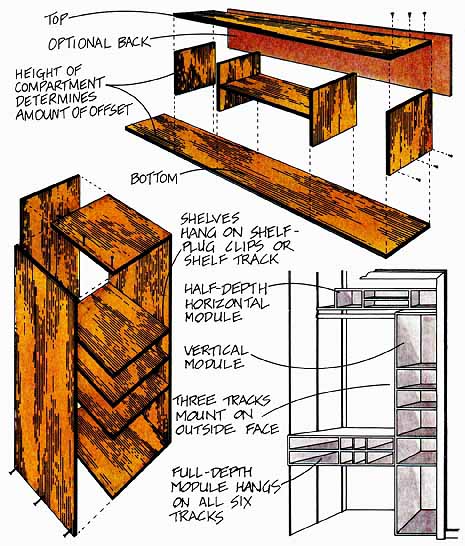Modules are essentially upside-down self-supporting shelves. Hung from the bottom of kitchen cabinets, small-scale modules allow you to put supplies and light-weight equipment right above the work areas where you need them. Fold-down doors can cover the contents. Wire baskets for vegetables and fruits stored at room temperature can be slipped into open-faced modules, as can covered boxes for staples. Add a middle shelf to one section, and you can store spices there too. Large-scale modules do bigger jobs. Sweaters, shirts, shoes, bags, hats, and boots are some of the many things you can keep conveniently in closet modules.
Small-Scale Modules
Here are some possible configurations for small-scale modules. Use 3/4-inch softwood lumber or plywood. To achieve a unified look, finish your modules to match existing surfaces.

Under-Cabinet Module Construction: Measure the space for the module, including the depth of the recess formed by the cabinet sides and bottom shelf. Record all dimensions on a freehand sketch. Plan your cutting list, keeping in mind that:
— the sides will extend into the recess under the cabinet and butt against the cabinet bottom; the sides will also overlay the module’s bottom piece. Account for this extra length and cut the sides so that the finished opening is the size you want.
— the bottom will butt between the sides.
— upright dividers should be 3/4 inch shorter than the side pieces, since the dividers butt against the module’s bottom piece.
— the door should be cut shorter than the sides so that it closes under the face frame.
— if you include a back, it will butt against the module’s sides and bottom piece.

Cut your materials to size. If you’re using plywood, determine which edges will be exposed and cover them with veneer tape. If you want a shaped edge for opening the door instead of a hardware pull, cut it now, using a curve-cutting saw. Sand all surfaces. Mark the position of the angle-bracket screw-holes, pre-drill, and screw the angle brackets to the sides and dividers. To assemble the module, start your nails in one side piece. Apply glue to the bottom and side piece where they will join, and nail them together. Repeat the process for the divider and the other side piece. Set the nail heads and putty the holes, then let the assembly dry.
Position the module in the cabinet recess and mark the angle-bracket screw-holes. Remove the module, and pre-drill. Finish both the unit and the door before you install them. When they are dry, screw a length of continuous hinge to the door and then screw that to the unit; you may need to pre-drill. Now install the unit under the cabinet. Then mount a spring or magnetic catch for the door, and a fold-down door stop if you want to limit the door’s swing to 90 degrees.
Large-Scale Modules
Large-scale modules can be built vertically for space-dividing storage units or horizontally for longer shelf surfaces. Large-scale modules are key components in the six-track closet system.
Closets and Verticals: In closets with interior widths up to 60 inches and a single door opening, install a single piece of 3/4-inch plywood to divide the space vertically; a vertical module would use too much space. In closets more than 60 inches wide, with door openings larger than 36 inches, vertical modules will work very well. One good basic design has a module in the center, built high enough that you can hang dresses and longer clothing on one side, and two rows of skirts, shirts, and pants on the other. A horizontal module can rest on top so that it has extra support over the longer span.
Horizontal Modules
— Modules mounted over eye-level closet poles will work best if you build them no deeper than 12 inches to 15 inches, so that you can see and reach the back.
— Modules or shelves mounted below eye-level will work best if you build them 20 inches to 22 inches deep: on the six-track system, all three tracks on each side will support them.
— Modules that run full-length from wall to wall must be designed with offset compartments to allow them to be moved into position. The offset should equal the height of the compartment.
— Modules that run between a wall and a vertical component don’t need to be offset since you can install the horizontal module in the closet before you add the vertical component; once in position, the horizontal module can be adjusted up and down easily.
Construction: Measure your closet space—its overall height and depth, its working width (the distance between faces of side-wall mounted track, for example), the dimensions of the door opening, and any other factors. Record the dimensions on a freehand sketch. Plan your component dimensions; determine which parts will be inset and which will overlay others. Backs add extra strength and rigidity. Since these components are not viewed from the side, the back can overlay the sides, bottom, and top, flush with the outer edges. The same construction process applies to either a horizontal or a vertical module. Cut the pieces to size and sand surfaces that will remain exposed. Apply veneer tape to plywood edges where they will be visible unless you plan to paint the component. Pre-drill and screw, or glue and nail, the parts together. Countersink and plug the screw- holes, or set the nails and fill the holes with putty. Let the component dry, then finish as you desire.
Apply side tracks to a vertical module as described in the six-track system, so that the tracks coordinate with those mounted on the side walls. Hang the rods and shelves where you want them, and the closet is ready to use.
